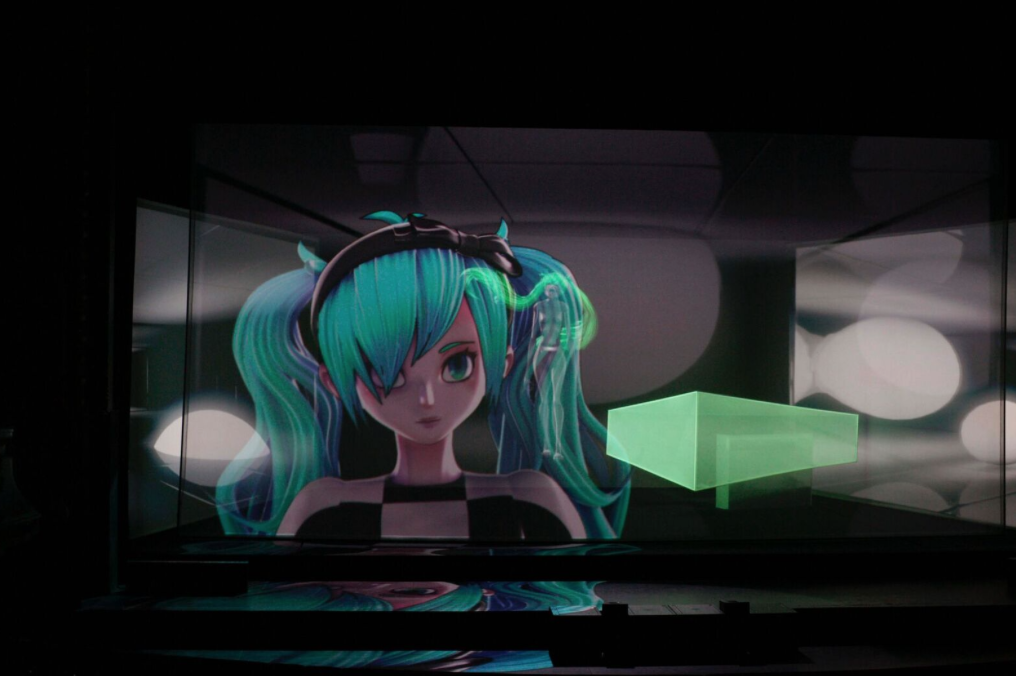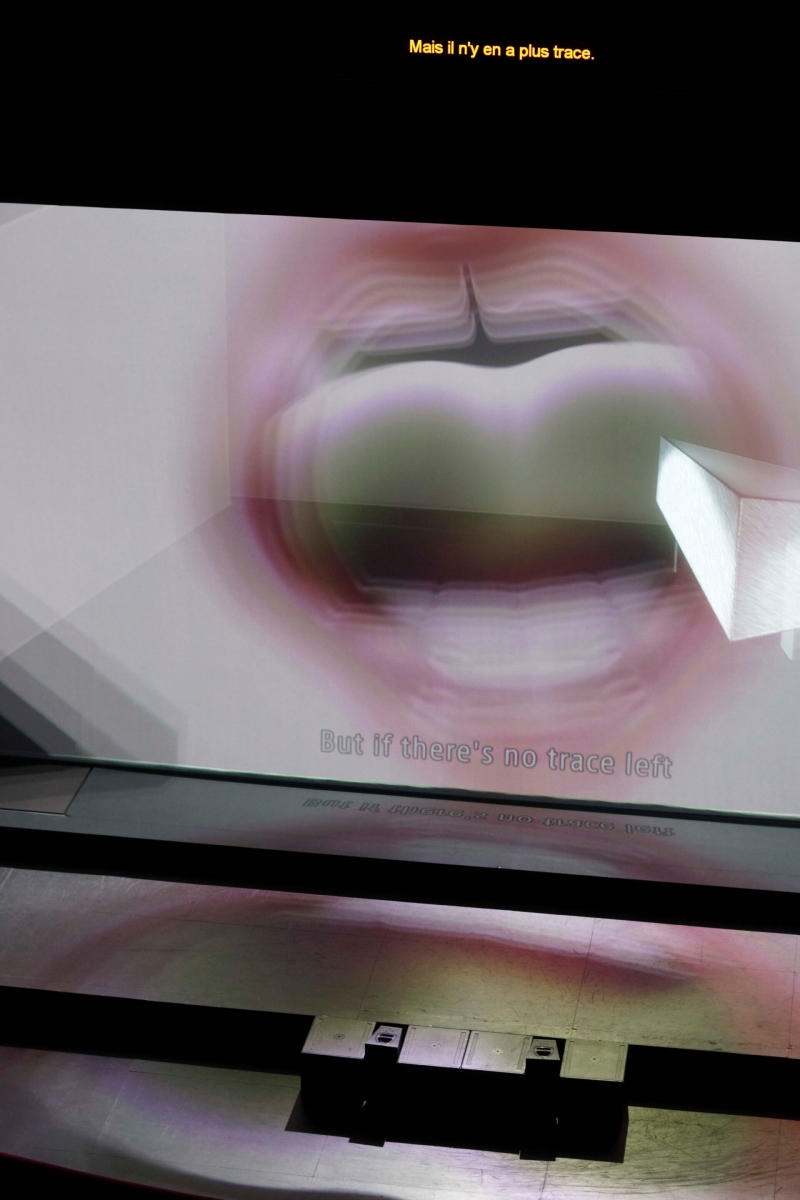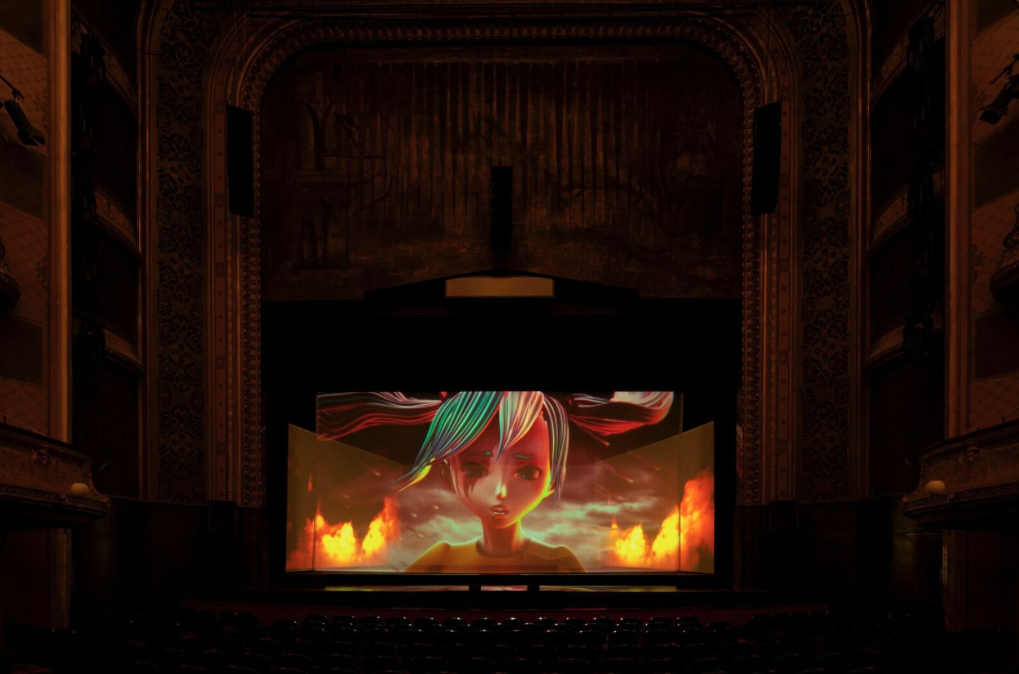The sound of a thousand escaping sighs fills the dark theatre. The stage remains curtained as synthesised string arpeggios fill the gloom before buzzing and static threatens to interrupt our anticipation. Digital disruptions ripple around us, as various colours of noise confirm that we aren’t in an analogue world anymore.
We hear vocaloid superstar Hatsune Miku offstage before we see her. Just when we start to think it has been dark for the longest time, a surtitle tells us exactly that. It’s a disarming start as we wonder if artificial intelligence has added mind reading to its capabilities. We enter the realm of Keiichiro Shibuya, artist and musician who, over the course of the next 90 minutes, will use Miku as his mouthpiece.
 The End: Keiichiro Shibuya & Hatsune Miku: Vocaloid Opera at the OzAsia Festival. Photo © Kenshu Shintsubo
The End: Keiichiro Shibuya & Hatsune Miku: Vocaloid Opera at the OzAsia Festival. Photo © Kenshu Shintsubo
Created in 2007, Hatsune Miku is a 3-D animated character that utilises singing synthesizer software. Outside of her foray into opera, Miku’s legions of fans compose her songs for her. The End sees Shibuya as composer, examining what it means to exist, and cease to exist. Conceived after the suicide death of his wife, this collaboration, with original book concept and libretto by Toshiki Okada premiered in 2013.
The scrim-clad stage is bathed in a sea of blue-green light, the same hue as Miku’s hair. Here, Shibuya produces the show from inside a prism, the changing skin of which aids the visual layers throughout. Graphically, this production is exceptional. Every inch of space is utilised as the anime characters, uninhibited by gravity, fly across different planes, lending as much to the texture of the scenes as the electrical timbre does to the picturesque score. With all that flying about, we can see right up Miku’s Louis Vuitton designed skirt, but that’s not the worst of it. Flying into her mouth and down her gullet is literally nauseating.
 The End: Keiichiro Shibuya & Hatsune Miku: Vocaloid Opera at the OzAsia Festival. Photo © Kenshu Shintsubo
The End: Keiichiro Shibuya & Hatsune Miku: Vocaloid Opera at the OzAsia Festival. Photo © Kenshu Shintsubo
As Miku combats an elephantine existential crisis, the complexity of the land- and sound- scapes intensifies to, at times, uncomfortable and invasive levels. We shield our eyes from starburst lights and feel syncopation pounding in our chests. This discomfort serves to further highlight how we relate to a character without humanity and cements The End as a show to be experienced, rather than simply watched.
Musically, an absence of the phrasing so necessary to breathing human singers jars at first, but there is ultimately so much to digest, it quickly becomes different, not better or worse. Curiously, vocal sostenuto is not better utilised.
Pre-programmed music and pre-produced visuals together with the absence of an orchestra and human performers, might lead some to question the label “opera”, but in the brave new world of Hatsune Miku, semantics seem superfluous.
Hatsune Miku’s sprinting scene reminds us of her non-human form; no one but an invention can run like that in 11-inch platform stilettos. Here, a key change steps up the pace, but makes us wonder why it took so long to arrive at wherever it is we now are. The recurring theme finally gives us something to audibly hold onto, as another version of Miku morphs again.
 The End: Keiichiro Shibuya & Hatsune Miku: Vocaloid Opera at the OzAsia Festival. Photo © Kenshu Shintsubo
The End: Keiichiro Shibuya & Hatsune Miku: Vocaloid Opera at the OzAsia Festival. Photo © Kenshu Shintsubo
False endings abound and it disarms to not know where we’re going, or come to think of it, where we’ve been. This becomes an all-at-sea experience that takes us out of our comfort zones, refusing to satiate our curiosity by providing anything close to an answer to the plethora of questions posed. Then, Miku opens a big cold box of reality on us, “You will die too,” she intones. Cheers.
Reincarnation is suggested, but ironically for a character created and fuelled by humans, there is not a hint of a higher power pulling the strings. It leaves us with a bizarre mix of desolation combined with a memory of hope, gathered from the frequency of major chords used throughout.
It’s still not the end, as we examine whether she is dead or asleep and by this point we’ve utterly exhausted our capacity to try and predict where this is going. Just when we consider if she even exists or not, her eyes start to bleed. Finally, we know exactly how she feels.
The End is a unique, taxing, contemporary work, full of surreal visions and stylised music, offering challenging concepts and sensory overload.











Comments
Log in to join the conversation.